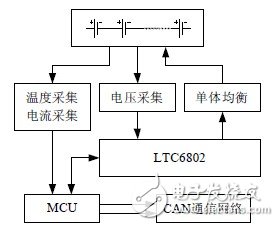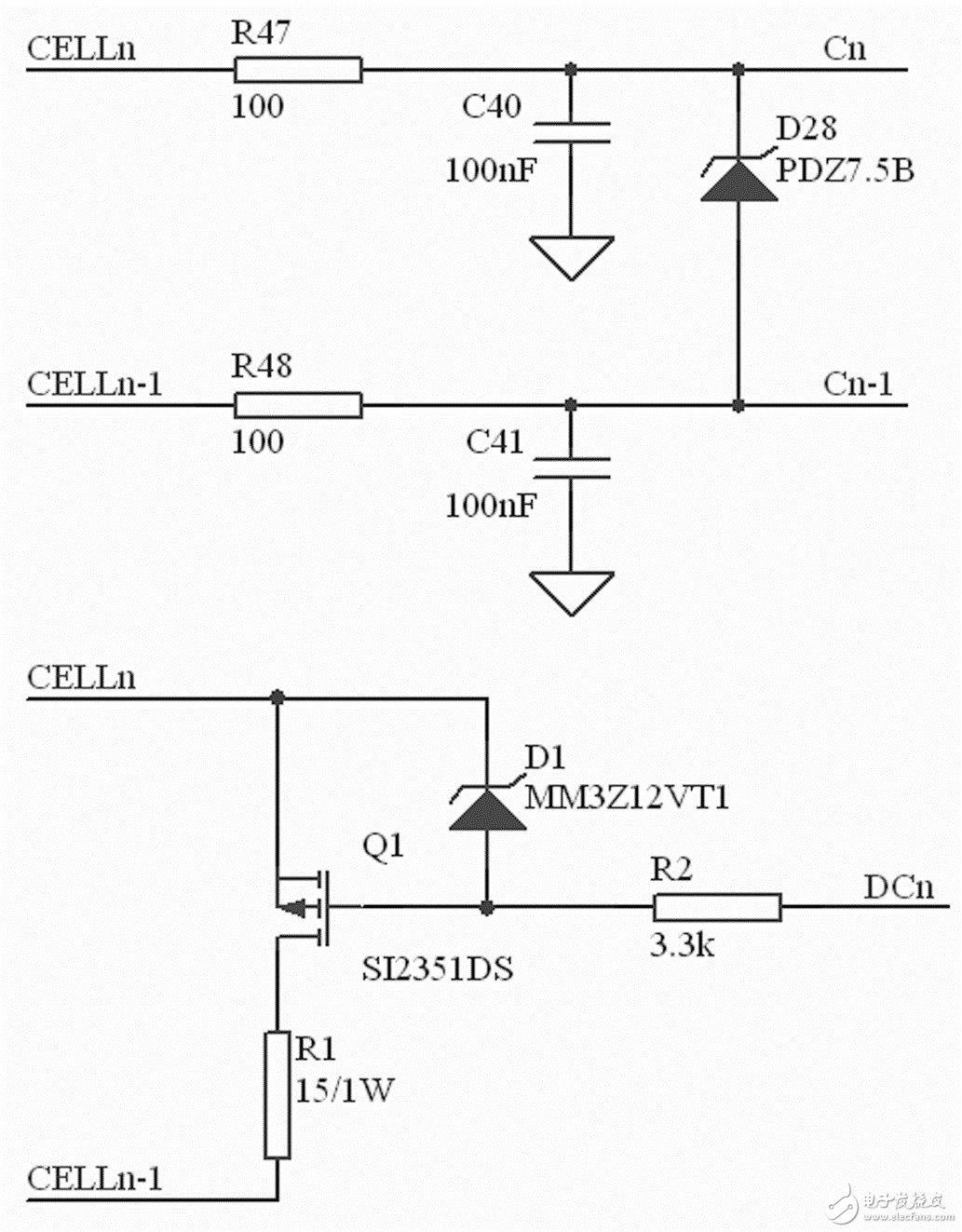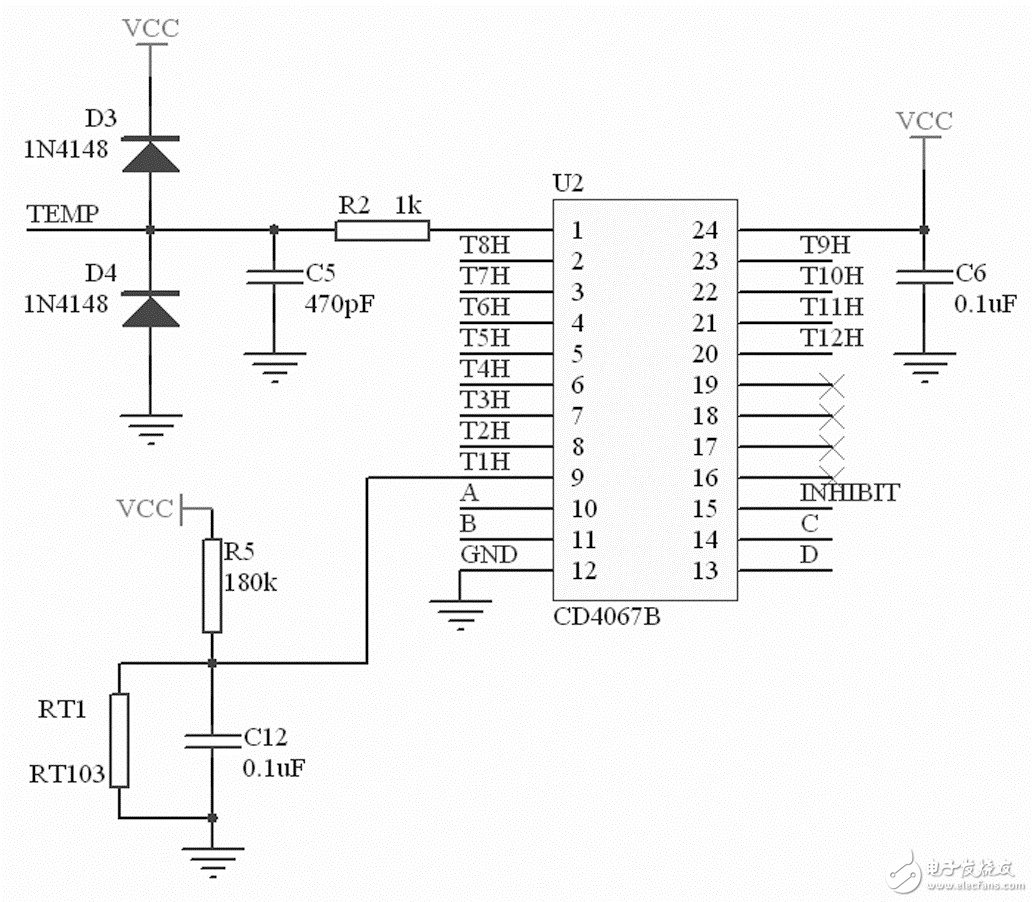Using a battery monitoring chip LTC6802 from Linear Technology of the United States, a monitoring platform for lithium-ion battery packs was designed. The system board can monitor up to 12 series of single cells, and can realize the monitoring of more cells in a distributed structure. The functions designed by the system include single voltage acquisition, single temperature acquisition, battery pack passive equalization, and distributed CAN communication. The main features of the LTC6802 are its high voltage acquisition accuracy and high integration. It has a good application prospect in battery applications, especially in pure electric/hybrid vehicles.
With environmental and energy issues becoming more and more serious, electric vehicles and hybrid vehicles (EV/HEV) have become the focus of attention in the world today. The battery is the power link of the EV, but its single terminal voltage and capacity are small. For example, the widely used lithium iron phosphate (LiFePO4) battery terminal voltage generally does not exceed 3.65 V, so it is often necessary to use multiple cells in series and parallel combination to meet Vehicle demand [1-3]. For a car battery pack, a fully functional monitoring system is essential. At present, there are two major problems in the domestic battery monitoring equipment: First, the battery voltage detection accuracy is not high, and second, the battery pack equalization control is more complicated to implement. In response to these problems, this paper uses Linear Technology's new battery pack monitoring chip LTC6802 to design a hardware monitoring platform for lithium-ion battery packs. The platform's design features include cell voltage/temperature sensing, battery pack equalization, and distributed CAN communication.
1 Battery Pack Monitor Chip LTC6802 Introduction
The LTC6802-1 is a chip specifically designed for battery pack monitoring. Each chip can detect up to 12 serially connected cell voltages with a total input voltage of up to 60V, either via a distributed bus structure or by directly connecting the chips in series. To achieve voltage detection of more series connected cells. In addition, the LTC6802-1 has the following features:
(1) With 12-bit ADC, high voltage acquisition accuracy, up to 5~8 mV; (2) Passive equalization function, can discharge over-voltage monomer through on-chip (or externally extended) MOSFET switch; 3) 1 MHz SPI compatible serial communication interface; (4) Strong anti-electromagnetic interference capability.
In general, the LTC6802 has a comprehensive battery pack monitoring function, high chip integration, and high voltage acquisition accuracy. In addition to EV/HEV, the main applications include high-power portable device power management and backup battery pack. System monitoring.
2 battery pack monitoring platform design
2.1 The overall structure of the battery monitoring system
The overall structure of the battery monitoring platform is shown in Figure 1. The platform is designed with a distributed CAN bus structure. First, the LTC6802 is used to achieve single-voltage acquisition and passive equalization control of the series battery pack; the main control chip is responsible for receiving voltage acquisition information from the LTC6802 and correlating the relevant parameters of the LTC6802. In addition, the MCU is also used to realize the battery pack node temperature and current collection; finally, the MCU sends the configuration information of the battery pack to the CAN communication network.

Figure 1 The overall structure of the battery monitoring platform
2.2 LTC6802 and MCU connection circuit design
The peripheral circuit of the LTC6802 and its connection circuit to the microcontroller are shown in Figure 2. The MCU in this circuit selects the Freescale series MC9S08DZ60. Its main function is to collect current and temperature, receive information from the LTC6802 and send the battery pack configuration information to the distributed CAN communication network.

Figure 2 LTC6802 and MCU connection circuit
The LTC6802 communicates with the MCU through its own SPI-compatible serial interface. For the LTC6802, CSBI is the chip select signal; SDO is the serial data output; SDI is the serial data input; and SCKI is the serial clock input.
In addition, in order to ensure the stability and reliability of the communication process, the electrostatic interference suppression circuit is also introduced in this design, as shown in Figure 2, D7-D15. The circuit consists of 8 diodes and a Zener diode. Actually, special ESD static can also be used. The protection device PRTR5V0U4D is implemented.
Another task of the MCU is to send battery pack configuration information to the CAN communication network. In this design, the CAN isolation driver chip ISO1050 is selected, as shown in Figure 2, U1. In order to further improve the anti-interference performance of CAN communication, the transient voltage suppression chip PSM712 is also used at the CAN output of the platform.
2.3 Voltage acquisition and equalization circuit design
The main function of the LTC6802 is to achieve the detection of the cell voltage in the battery pack and the equalization control under the overvoltage condition of the cell. The LTC6802 has a 12-bit ADC that can detect voltages of up to 12 series-connected cells. The voltage acquisition circuit on the periphery of the chip is also relatively simple. Simply connect the positive and negative terminals of the single chip to the corresponding single-cell voltage input terminal of the chip. In order to suppress high frequency noise in the voltage signal, an RC low-pass filter is added to the circuit. In addition, the LTC6802 features a MOSFET drive output with a 10k pull-up resistor for driving external MOSFETs.
For the monomer n in the series battery pack, the corresponding voltage acquisition circuit and equalization control circuit are shown in Figure 3. The above figure shows the voltage acquisition circuit, and the figure below shows the equalization control circuit. In the figure, CELLn and CELLn-1 are respectively connected to the positive and negative terminals of the monomer n; Cn and Cn-1 are the LTC6802 voltage acquisition input terminals; and DCn is the MOSFET drive output terminal of the LTC6802. When the monomer n is overpressured
2.4 Temperature acquisition circuit design
The battery pack node temperature is also an important parameter in the configuration information. In this platform, the detection of the node temperature is realized by the MCU, and each node of the design is designed to take a total of 12 nodes for temperature detection. The temperature acquisition circuit is shown in Figure 4. The connection circuit of node 1 is shown in the figure. First, the design selects the thermistor RT103 as the temperature sensing element to convert the temperature signal into a voltage signal. Then, the voltage signal is input to the analog switching device CD4067D, and the four control terminals of the ABCD can be configured to strobe the input signal through the MCU. It is output by its common terminal, pin 1. Finally, the signal output from the analog switch is input to the AD input of the MCU through RC filtering and limiting processing, and the node temperature acquisition is realized.

Figure 3 voltage acquisition and equalization circuit

Figure 4 temperature acquisition circuit
3 Conclusion
Based on the battery monitoring chip LTC6802 and the Freescale series microcontroller MC9S08DZ60, this paper designs a monitoring platform for the series lithium-ion battery pack. The paper combines the characteristics of the chip and the platform application to design the voltage detection circuit, equalization control circuit, temperature acquisition circuit, SPI communication and CAN communication circuit. The platform makes full use of the LTC6802's high integration, high voltage acquisition accuracy and strong anti-interference ability, which greatly improves the poor voltage acquisition accuracy and complex circuit structure of the traditional battery monitoring circuit. It can be asserted that in the EV/HEV industry, when the LTC6802-based battery pack monitoring platform has strong application value and good application prospects, Q1 will be turned on and discharged, and the discharged power will be consumed on the resistor R1.
Laptop AC adapter for common brands, such as HP, Sony, Lenovo, Dell, Asus, Toshiba, Acer, Samsung etc. Our products have high quality and reasonable price.
CE, FCC, ROHS certification are approved by our products, and it have two years warranty. Built with input/output overvoltage protection, input/output overcurrent protection, over temperature protection, over power protection and short circuit protection. We are a professional power adapter manufacturer in China. We can meet your specific requirement. We have perfect after-sale service and technical support.
Hope we can establish friendly business relationship with you in the near future!
Laptop Adapter,Adapter For Macbook,Power Supply For Macbook, Charger For Macbook
Shenzhen Waweis Technology Co., Ltd. , https://www.waweis.com